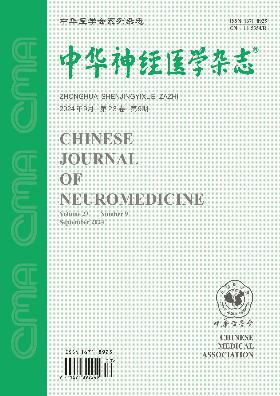Quantitative assessment of white matter damage caused by delayed neuropsychiatric sequelae after carbon monoxide poisoning with diffusion kurtosis imaging
Q4 Medicine
引用次数: 0
Abstract
Objective To investigate the value of quantitative evaluation in white matter damage caused by delayed neuropsychiatric sequelae (DNS) after carbon monoxide poisoning (CO) with diffuse kurtosis imaging (DKI). Methods A prospective study was conducted from November 2016 to February 2019 in 28 patients diagnosed as having DNS after CO poisoning and 30 healthy controls in our hospital. DKI scans were performed within 7 d of onset and DKI-derived parameters (9 regions of interest), including mean kurtosis (MK), axial kurtosis (AK), and radial kurtosis (RK), were obtained. Mini Mental State Examination Scale (MMSE), Barthel Index, Verbal Fluency Test (VFT), and Digital Breadth Test (DST) were performed on both subjects to conduct neurocognitive assessment; multivariate regression analysis was performed to determine the statistical relations of scores of above neurocognitive scales with AK values of ROIs. Results As compared with those in the control group,the MK, AK and RK values in all ROIs showed an increased trend in DNS group; among which, the anterior semioval center, posterior semioval center and frontal lobe enjoyed the most obvious increase, with significant differences (P<0.05). In the genu of corpus callosum, body of corpus callosum and parietal lobe, the AK value of DNS group was significantly higher than that in the controls (P<0.05). Except for temporal lobe and occipital lobe, area under the curve (AUC) of AK value of other ROIs in diagnosing DNS was larger than that of RK and MK values of other ROIs; AK value of anterior semioval center (AUC=0.802, P=0.000), posterior semioval center (AUC=0.785, P=0.000), frontal lobe (AUC=0.749, P=0.001), genu of corpus callosum, (AUC=0.730, P=0.003), parietal lobe (AUC=0.699, P=0.009) and body of corpus callosum (AUC=0.654, P=0.045) had better performance than RK and MK in diagnosing DNS, with statistically significant differences (P<0.05). Multivariate regression analysis results show that the DST value (reverse) is the independent influencing factors of AK values of anterior semioval center, genu of corpus callosum, and frontal lobe; VET (vegetable) is the independent influencing factors of AK values of body of corpus callosum, age is the independent influencing factors of AK values of posterior semioval center, splenium of corpus callosum, and frontal, temporal and occipital lobes; and education is the independent influencing factors of AK values of temporal lobe. Conclusion DKI can quantitatively evaluate the microstructural damage of white matter caused by DNS, and the increase of AK is related to the decrease of neurological function in patients with DNS. Key words: Delayed neuropsychiatric sequelae; White matter; Diffusion kurtosis imaging; Magnetic resonance imaging弥散峰度成像定量评价一氧化碳中毒后迟发性神经精神后遗症所致白质损伤
目的探讨弥漫性峰度成像(DKI)定量评价一氧化碳中毒(CO)后迟发性神经精神后遗症(DNS)所致脑白质损伤的价值。方法对2016年11月至2019年2月在我院诊断为一氧化碳中毒后发生DNS的28例患者和30例健康对照进行前瞻性研究。DKI扫描在发病后7天内进行,并获得DKI衍生参数(9个感兴趣区域),包括平均峰度(MK)、轴向峰度(AK)和径向峰度(RK)。采用迷你精神状态测试量表(MMSE)、Barthel指数(Barthel Index)、语言流畅性测试(VFT)和数字广度测试(DST)对两组受试者进行神经认知评估;采用多元回归分析确定上述神经认知量表得分与roi AK值的统计关系。结果与对照组相比,DNS组各roi的MK、AK、RK值均有升高趋势;其中,前半瓣中枢、后半瓣中枢和额叶增加最为明显,差异有统计学意义(P<0.05)。在胼胝体膝、胼胝体和顶叶中,DNS组AK值显著高于对照组(P<0.05)。除颞叶和枕叶外,其他roi的AK值诊断DNS的曲线下面积(AUC)均大于其他roi的RK和MK值;前半叶中心(AUC=0.802, P=0.000)、后半叶中心(AUC=0.785, P=0.000)、额叶(AUC=0.749, P=0.001)、胼胝体膝(AUC=0.730, P=0.003)、顶叶(AUC=0.699, P=0.009)、胼胝体体(AUC=0.654, P=0.045)的AK值诊断DNS优于RK和MK,差异有统计学意义(P<0.05)。多因素回归分析结果显示,DST值(反向)是影响前半叶中心、胼胝体膝、额叶AK值的独立因素;VET(蔬菜)是胼胝体体AK值的独立影响因素,年龄是胼胝体后半叶中心、胼胝体脾、额叶、颞叶和枕叶AK值的独立影响因素;教育是颞叶AK值的独立影响因素。结论DKI可定量评价DNS引起的脑白质微结构损伤,AK升高与DNS患者神经功能下降有关。关键词:迟发性神经精神后遗症;白质;扩散峰度成像;磁共振成像
本文章由计算机程序翻译,如有差异,请以英文原文为准。
求助全文
约1分钟内获得全文
求助全文
来源期刊

中华神经医学杂志
Psychology-Neuropsychology and Physiological Psychology
CiteScore
0.30
自引率
0.00%
发文量
6272
期刊介绍:
 求助内容:
求助内容: 应助结果提醒方式:
应助结果提醒方式:


